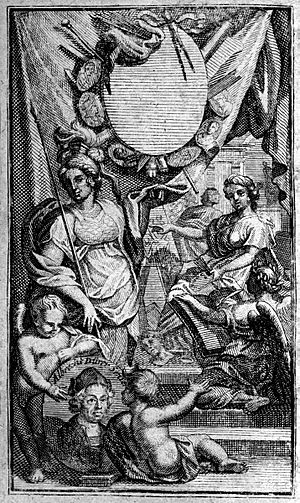Roger de Piles facts for kids
Roger de Piles (born October 7, 1635 – died April 5, 1709) was a talented French artist. He was a painter, an engraver, and an art critic. He also worked as a diplomat for France.
Contents
Roger de Piles' Life Story
Roger de Piles was born in a town called Clamecy. He studied important subjects like philosophy and theology. But he loved painting the most and spent his time on it.
In 1662, he became a teacher to Michel Amelot de Gournay. Roger de Piles stayed with Amelot throughout his life. He worked as a secretary for Amelot's important trips. Amelot was a French ambassador to places like Venice, Portugal, and Spain.
Roger de Piles traveled to Italy two times. The first trip was in 1673–1674. He went as Amelot's teacher during Amelot's Grand Tour. This was a trip young noblemen took to learn about art and culture. His second trip was from 1682–1685. He went as Amelot's secretary when Amelot became the French Ambassador to Venice. During this time, Roger de Piles joined an art group in Bologna called dei Gelati. This was likely thanks to his friend Carlo Cesare Malvasia.
In Venice (1682–1685), Roger de Piles started a famous collection. He collected prints, drawings, and paintings. Some artists in his collection included Giorgione, Correggio, Rembrandt, Claude Lorrain, Rubens, Antoine Coypel, and Jean-Baptiste Forest.
He also became interested in secret missions for his country. He would travel to study art collections in Europe. But he also bought art for King Louis XIV of France. These art trips were a cover for his secret tasks. For example, he went to Germany and Austria in 1685. He was working for the King's minister, the marquis de Louvois.
Roger de Piles was not always lucky with his secret work. In 1692, during a war, he was caught in the Hague. He had a fake passport and was held for five years. He used this time to write a book. It was called L'Abrégé de la vie des peintres. This book was published in 1699. After his release, he became an honorary advisor to the Académie de peinture et de sculpture.
In 1705, he went with Amelot de Gournay to Spain. But he got sick and had to return to Paris. He passed away there in 1709.
Roger de Piles as an Art Critic
Roger de Piles made a big impact on how people thought about art. He wrote a book called Dialogue sur le coloris (which means "Dialogue on Colors"). In this book, he started a famous discussion. It was about whether drawing or color was more important in a painting.
This debate began in 1671. Artist Philippe de Champaigne had given a talk about Titian's painting. Roger de Piles defended the artist Rubens. Rubens was known for his amazing use of color.
This discussion was like an early debate between "classic" and "modern" art. The "classic" approach focused on perfect proportions and perspective in drawing. The "modern" approach, which Roger de Piles favored, focused on the use of color and brush strokes.
During this debate, Roger de Piles used the term "clair-obscur" (Chiaroscuro). This term describes how light and dark areas in a painting create a strong effect. His ideas about color influenced other famous artists. These included Antoine Coypel, Hyacinthe Rigaud, Nicolas de Largillière, and François de Troy.
The Balance of Painters
In his last book, Cours de peinture par principes avec un balance de peintres (1708), Roger de Piles added a special list. It included fifty-six important painters. He had studied their work as an expert during his travels.
For each painter, he gave scores from 0 to 18. He scored them on four things:
- Composition (how the painting is arranged)
- Drawing (the lines and shapes)
- Color (how colors are used)
- Expression (the feelings shown in the painting)
This list showed his ideas about art. He believed there should be a good balance between color and design. The highest scores went to Raphael and Rubens. Rubens got slightly higher scores for color. Raphael got slightly higher scores for drawing.
Some painters scored very low in certain areas. For example, Michelangelo Caravaggio got 16 for color but 0 for expression. Painters like Lucas van Leyden, Sebastian Bourdon, and Albrecht Dürer scored lower overall. But they had a perfect balance between color and design.
Roger de Piles' "Balance of Painters" was talked about a lot. Some art critics in the 1700s even made fun of it. Artist William Hogarth showed this in his print, Enthusiasm Delineated.
Writings
- De Arte Graphica (1668) - This was a French translation of another artist's work. Roger de Piles added his own thoughts.
- Dialogue sur le coloris (Dialogue upon Colour, 1673) - His famous book about color in art.
- La Vie de Rubens (The Life of Rubens, 1681) - A book about the life of the artist Rubens.
- L'Abrégé de la vie des peintres (Summary of the Lives of Painters, 1699) - A book with biographies of many painters.
- Cours de peinture par principes avec un balance de peintres (The Principles of Painting, 1708) - His last book, which included his famous "Balance of Painters" list.
Images for kids
See also
 In Spanish: Roger de Piles para niños
In Spanish: Roger de Piles para niños



